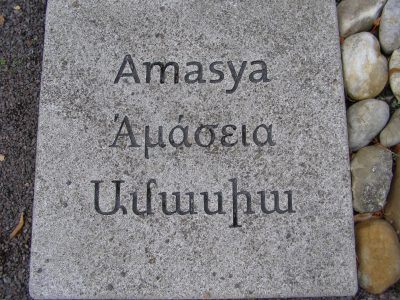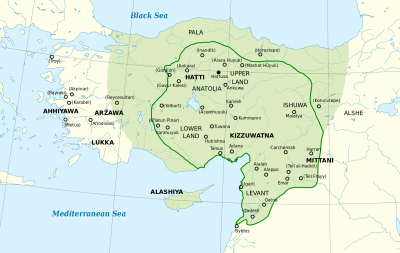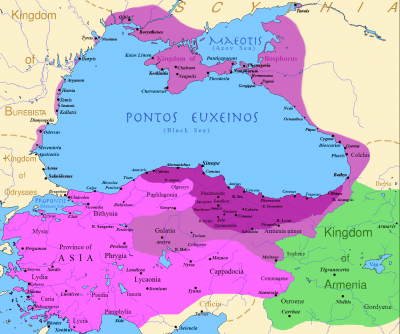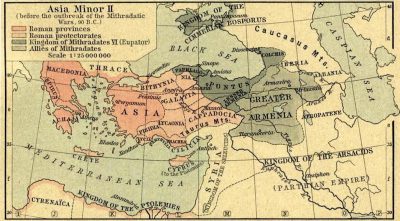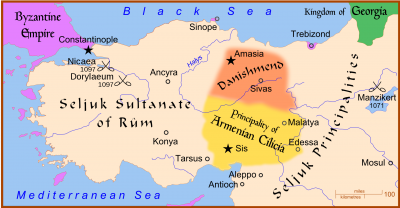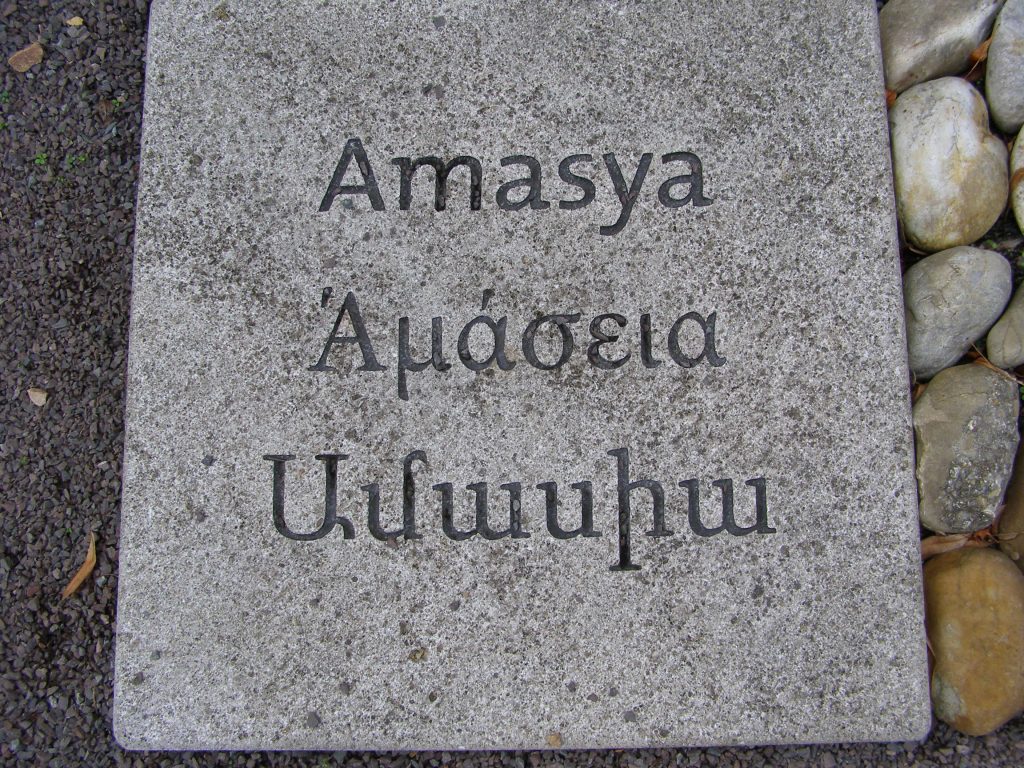
Administration
The Ottoman sancak Amasya consisted of seven kazas: Amasya, Merzifon/Marzvan, Ladik, Havza, Vezirköprü, Gümüşhaciköy, and Mecidözü.
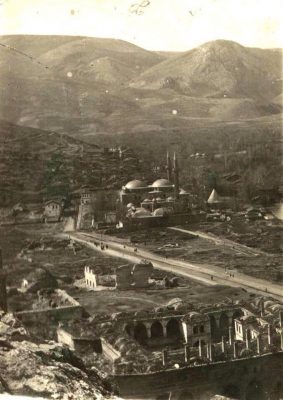
Population
“The sancak of Amasia, with its roughly 200,000 inhabitants, including 31,717 Armenians and 39,676 Greeks, was on the eve of the First World War an extraordinary museum of the customs of the native populations of Asia Minor.”[1]
According to the Armenian Patriarch Malachia Ormanian, there lived 25,000 Armenian Apostolic Christians in the sancak of Amasya, 2,000 Catholic and 500 Armenians.[2]
In his analytical census, Dimosthenis Ikonomidis (Oeconomidis) put the pre-war number of Orthodox Greeks in the sancak Amasya at 55,000.[3]
Greek settlements
Αλαμάντσιφλικ – Alamantsiflik (Alamançiftlik)
Γούχαγιαπουλάρ – Yioukhayiapoular
Σότζαγη – Sotzagi
Τουσούζ – Tousouz
Σιχλάρ – Sikhlar (Sihlar)
Ζιερέ – Ziere
Σαλαμούρ – Salamour
Σάζνταγι – Sazntayi
Σιχλάρια – Sikhlaria
Τουζσούζ – Touzsouz Ζιερέ – Ziere
Ζόανα – Zoana
Φουντουκλή – Fountoukli (Fundukli)
Κιουρουτσάκ – Kiouroutsak
Καράτσοριν – Karatsorin
Ακ Πουνάρ – Ak Pounar (Akpunar)
Σαρή Καγιά – Sari Kayia
Αγτζά-Κιόι – Agtza-Kioy
Αμπαντζή – Ampantzi
Χιτίρ-Κιόι – Hitir-Kioy
Γιρτή Κιόζ – Yirti Kioz
Μερζουφούντα – Merzoufounta (Trk.: Merzifon)
Παγιάτ – Payiat
Κολίς – Kolis
Βεζίρ Κιοπρού – Vezir Kioprou
Μαχματλού – Makhmatlou
Πατσάς – Patsas
Σουλεϊμάν Κιόι – Suleyman Kioy
Ερσαντιά – Ersantia
Κοτσάκ – Kotsak
Σαριτζίκ – Saritzik
Πουτσούκ Τσιφλίκ – Poutsouk Tsiflik
Καπλάν – Kaplan
Καγιά Αρασί – Kayia Arasi
Καπακλή Εσμέ – Kapakli Esme
Τερ-Κιόι – Ter-kioy (Terköy)
Χατζή-Γιούρτ – Hatzi-Yiourt (Haciyurt)
Κουργούη – Kourgooy
Τιζούρτ – Tizourt
Πιρτανέ – Pirtaneh
Μποχτσά Αρμούτ – Mpoktsa Armout
Ιντζιρλί – Intzirli
Αρμουτλού – Armoutlou
Γιαρπάς – Giarpas
Πέλουζα – Pelouza
Τσαπνή – Tsapni
Γαρεντή – Garenti
Σουγουτζάκ – Sougoutzak
Καρλούκ – Karlouk
Τσορτικλή – Tsortikli
Σιχσιρίν – Sikhsirin
Τσάι Κουνεγί – Tsai Kounegi
Καράτσιπε – Karatsipe
Τινακλί – Tinakli
Κοζέμορα – Kozemora
Τιρνάκελι – Tirnakeli
Κάβζα – Kavza
Καράτζαρεν – Karatzaren
Φουντουτσάκ – Fountoutsak
Καρά Κιαβουβλάρ – Kara Kiavouvlar
Χαρμαντζίκ – Kharmantzik
Ικί Πεχρεμέ – Iki Pekhreme
Σιβρί Αλτί – Sivri Alti
Πέιλαν – Peylan[4]
History
Today’s Amasya is the successor of the ancient city of Amaseia. The history of Amasya goes back to Hittite times, but it attained its most important significance in Hellenistic times: from about 300 B.C. to 183 B.C. Amaseia was the capital of the kingdom of Pontos, after which the capital was transferred to Sinope, which is located by the sea. In the 3rd Mithridatic War the city was conquered by the Romans in 70 B.C. and in 64 B.C. it was assigned first to the Roman province of Bithynia et Pontus, and since 25 B.C. to the province of Galatia.
In late antiquity the city was Metropolis of the province of Diospontus or Helenopontus, and in Byzantine times it was the seat of the Thema Armeniakon. The Christian soldier Theodore (Theodoros) of Euchaïta suffered martyrdom here around 306; he is said to have burned the Magna Mater temple in the city and was tortured and burned for it. The Danishmendid emir Danishmend Ghazi conquered the city in 1075 and held it until it passed to the Seljuk ruler Kiliç Arslan II in the late 12th century.
In 1386, the region around Amasya became part of the Ottoman Empire. In Ottoman times, Amasya reached a heyday from 1396 as the residence of the princes of the ruling dynasty and was referred to as the Baghdad of Rum or the Oxford of the East, as important educational institutions were located here. However, by the 19th century at the latest, Amasya lost its importance.
In the Turkish War of Independence (1919-1922), Mustafa Kemal called for national resistance from here on 22 June 1919, and convened the Congress of Sivas.
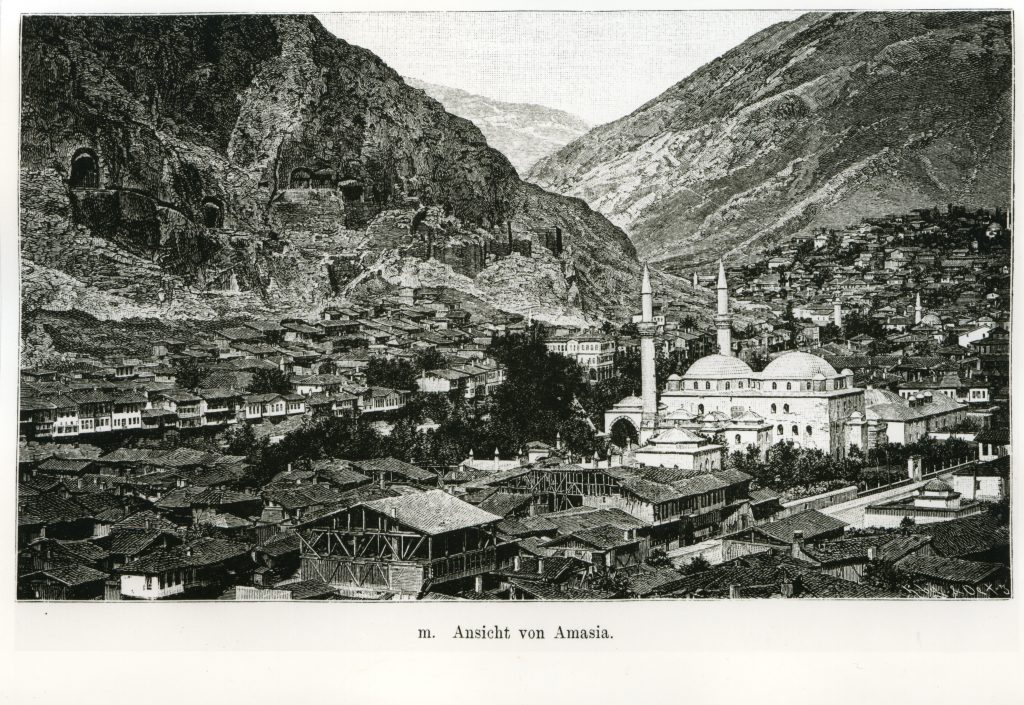
Destruction
During the years of World War I and the Turkish War of Independence, the Christian inhabitants of Amasya (Armenian and Greek) suffered from atrocities. Many Armenian civilians fleeing the attacks sought refuge at the American missionary school Anatolia College, located in Merzifon outside Amasya. In 1921, Turkish troops closed down the school, and the local population relocated to Thessaloniki after the compulsory population exchange between Greece and Turkey. Also, in 1921 there was the Amasya trials which were special ad hoc trials, organized by the Turkish National Movement, with the purpose to kill the Greek representatives of Pontos region under a legal pretext.
The destruction of the Armenian population in the sancak of Amasya started on 15 March 1915 when the authorities arrested 17 Armenian men involved in politics and education in Merzifun and Amasya. They were interned in the medrese of Sifahdiye at Sivas.[5] On 18 May 1915, futher Armenian notables in Amasya were taken in for questioning and were tortured, then executed by axe on 23 May in an isolated region three hours from town, at Saz Mountain. The systematic arrest of men, particularly artisans, began on 14 June 1915 and climaxed with their execution on 29 June, when they were taken out under the cover of night in four convoys, tied together in groups of four, and killed in the Amasya region.
Between 3-7 July 1915, around 12,000 Armenians were deported in five convoys. After they reach Kangal, the convoys from Amasya saw all their males over the ages of eight year executed at Sarkışla around 15 July by Turkish villagers and Circassians commanded by Halil Bey, the Commander of the bandit squadrons of the province of Sıvas. The remainders were then sent in the direction of Hasançelebi and Fırıncılar, where the first convoy arrived on 7 September, and then Suruc, Arabbunar, Bab, Aleppo, Meskene, and Der el-Zor. In the end of December 1919, 3,000 Armenian escapees from the sancak of Amasya were counted.[6]
The Black Book (1919) of the Ecumenical Patriarchate of Constantinople quantifies the number of Greek Orthodox Christians deported from the ‘Amasya region’ during WW1 at 89,370.[7]
